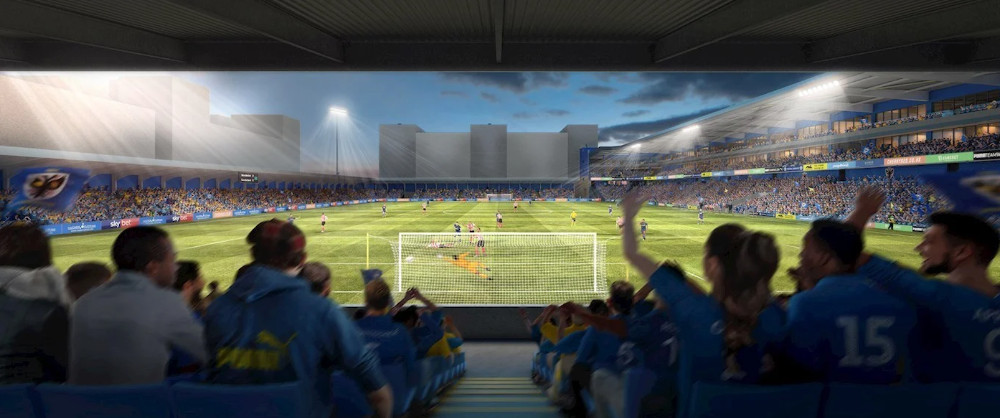
AFC Wimbledon – past, present and future
AFC Wimbledon – past, present and future
Max Copeman has the lowdown on the latest plans at AFC Wimbledon and looks back on the fascinating history of the club
AFC Wimbledon’s backstory is unlike any other football club’s. After only being founded in 2002, “The Dons” is one of the youngest clubs in the English football league system, yet its heritage predates that by a long way. In 2001, a consortium of businessmen struck a deal with executives of the historic Wimbledon F.C. to relocate over 50 miles north from their traditional home in south London to Milton Keynes. Despite strong opposition from supporters groups, the move went ahead and the team was soon renamed to Milton Keynes Dons F.C., bringing an end to Wimbledon F.C.’s 110-year history. However, defiant in their objection to the decision, a large group of supporters decided to form their own club and start afresh from the very bottom of English football, forming AFC Wimbledon as we know it.
HISTORY OF AFC WIMBLEDON
Nine seasons and five promotions later, the team finally found itself back in the football league in 2011, before being promoted to League 1 in 2016. Much of the early success was thanks to club legends and lower league cult heroes Kevin Cooper, Joe Sheerin and Jason Goodliffe, before captain Barry Fuller lead the team between 2014 and 2018. Striker and current Sky Sports pundit Adebayo Akinfenwa also became a fan favourite after winning Player of the Year in 2015.
Although technically a different club to Wimbledon F.C., AFC Wimbledon has continued to cherish the heritage and tradition of its parent team, which enjoyed its most successful period after being promoted to the First Division in 1986. Perhaps the club’s most famous moment came in 1988, when a team lead by captain Vinnie Jones became known as “The Crazy Gang” for their rough and ready approach while marching on to a famous FA Cup final win over champions Liverpool. Since 2003 The Dons have also had a successful women’s team, AFC Wimbledon Ladies, who play their FA Women’s Nation League Division One home matches at Colston Avenue ground in Carshalton, Sutton.
From 1912 to 1998 Wimbledon F.C.’s home ground was Plough Lane, located a stone’s throw from Haydons Road rail station. The fans behind AFC Wimbledon never forgot this, and now the dream of returning to this site is becoming a reality. Since 2002, the first team have had home matches at Kingsmeadow in Norbiton, a ground with a capacity of just under 5,000. Yet in May 2020, AFC Wimbledon finally left the modest venue to groundshare with QPR while they await the completion of their brand new, more than 9,000-seater Plough Lane stadium on the old site of Wimbledon Greyhound Stadium, just 250 yards from Wimbledon F.C.’s old home.
AFC Wimbledon opens new stadium in SW19
Although the Covid-19 pandemic has inevitably slowed progress on the development, AFC Wimbledon chairman Joe Palmer stated this week that the club intend to host their first game in the new stadium on November 3rd against Doncaster Rovers. “If all goes to plan, the Doncaster game will mark a real milestone. Not only will we be opening the doors on our brand-new home, we will also be witnessing the start of a brand-new era for our club,” he said.
Palmer added that the stadium, which will also have the potential to be eventually expanded into a 20,000-seater venue in Wimbledon, will be completed by October 25 and will host test matches before the Doncaster fixture. With the pandemic forcing all football matches to be played behind closed doors, Palmer also lamented the absence of AFC Wimbledon fans: “While November 3 promises to be a momentous occasion for everyone, it looks highly likely there will be one major ingredient missing. We had hoped that at least some – if not all – fans would be allowed back into stadiums by October but, as you know by now, the government has currently abandoned those plans.”
For some supporters, however, being absent for the club’s return to its spiritual home hasn’t dampened their positivity towards the future. Describing the stadium move as “a source of great pride and emotion”, Xavier Wiggins, spokesperson for Dons Local Action Group, said the lack of fans “won’t be forever and will mean we will appreciate it even more we get back into grounds”.
The pandemic has thrown a number of lower-league clubs into financial trouble, with some struggling to survive, but chairman Palmer was quick to say that this is fortunately not the current case for AFC Wimbledon. “For the time being at least, we are not in such a perilous position, although it remains imperative that we reach all our revenue targets and that we do not fall into complacency,” he said.
For Wiggins, who was also one of the key figures behind the Plough Lane Bond fundraising scheme to help support the new stadium move, such reassurances are invaluable, but also a testament to how the club is run. “The club has a record of overachieving and removing obstacles,” he said. “Success is not about gambling on promotion and chasing short-term on-pitch success for the 1st team at the expense of normal logic and a cohesive, community club ethos. Football clubs can have such a positive influence on their communities.”






